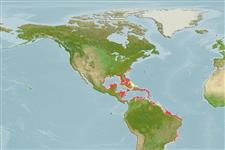Environment: milieu / climate zone / depth range / distribution range
Ecology
Marine; reef-associated. Tropical
Southwestern Atlantic: Belize, Central America, and Puerto Rico; Caribbean, to
Santa Catarina State, southern Brazil.
Size / Weight / Age
Maturity: Lm ? range ? - ? cm
Max length : 8.2 cm TL male/unsexed; (Ref. 13628)
Dorsal spines (total): 20; Dorsal soft rays (total): 9 - 11; Anal spines: 2; Anal soft rays: 7 - 21. This species is distinguished from its southwestern Atlantic congeners by the following set of characters: D XX,9-11 (rarely XIX or XXI); A II,17-21; pectoral-fin rays14-15 (rarely 13); length of third pelvic-fin ray contained 2.5 to 3.0 times in second pelvic-fin ray; lateral-line scales 48-56; total nuchal cirri 24-36; pectoral-fin base and midline before dorsal-fin no scales; breast usually fully scaled in males, often naked in females; pores 2-3 from preopercular canal onto opercle. Colouration: pattern dominated by 5-6 (rarely 7), saddle-like bars on body, extending to spiny dorsal fin (Ref. 123106).
Occurs in shallo reefs (Ref. 123106), on sandy bottoms and Thalassia testudinum beds (Ref. 13628). Feeds mainly on crustaceans but also on gastropods and worms (Ref. 13628).
Life cycle and mating behavior
Maturities | Reproduction | Spawnings | Egg(s) | Fecundities | Larvae
Carvalho-Filho, A., I. Sazima, S.M.Q. Lima, D. Almeida, L. Mendes, R.M. Dias, M.R. Britto and J.L. Gasparini, 2020. Review of the genus Malacoctenus (Actinopterygii: Labrisomidae) from the Southwestern Atlantic, with description of two new species. Zootaxa 4819(3):499-520. (Ref. 123106)
IUCN Red List Status (Ref. 130435)
Threat to humans
Harmless
Human uses
Tools
Special reports
Download XML
Internet sources
Estimates based on models
Preferred temperature (Ref.
123201): 24.1 - 28.1, mean 27.3 °C (based on 722 cells).
Phylogenetic diversity index (Ref.
82804): PD
50 = 0.5000 [Uniqueness, from 0.5 = low to 2.0 = high].
Bayesian length-weight: a=0.00603 (0.00294 - 0.01235), b=3.08 (2.89 - 3.27), in cm total length, based on LWR estimates for this species & (Sub)family-body (Ref.
93245).
Trophic level (Ref.
69278): 3.4 ±0.49 se; based on food items.
Resilience (Ref.
120179): Medium, minimum population doubling time 1.4 - 4.4 years (Fec = 4,000).
Fishing Vulnerability (Ref.
59153): Low vulnerability (10 of 100).
Nutrients (Ref.
124155): Calcium = 146 [72, 238] mg/100g; Iron = 0.757 [0.435, 1.292] mg/100g; Protein = 18.2 [17.1, 19.3] %; Omega3 = 0.0978 [, ] g/100g; Selenium = 22.2 [9.4, 48.7] μg/100g; VitaminA = 181 [57, 582] μg/100g; Zinc = 2.25 [1.47, 3.24] mg/100g (wet weight);
